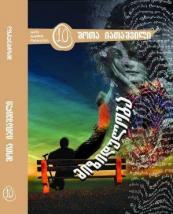GRAVITATION
As for Gravitation, this is a selection of Shota Iatashvili’s stories. It includes the best stories from the collection Backlighting (1998), The Flower of Flowers and the Engineer (2000), Photodaddies (2005) and texts written afterwards. The book opens with an extensive story The Sick Town written in 1992: in this story describes, as a parable, Tbilisi’s civil war events of 1991-2, which ended in the overthrow of President ZviadGamsakhurdia. The author wrote this text write in the nightmarish period of unaccountability: there was actually no distancing involved to allow for analysis and evaluation of events. That is why the work is distinguished by its extremely tense emotions, by its quantity of ghostly, cruel figures and, at the same time, by an idiosyncratic lyricism. This book contains several stories which are autobiographical. Among them is Memento Vitae, which the author makes very effective by montage effects: he sticks together with great craft short clips of various periods and various moods. ‘How We Chased Death out of the House’ and ‘’My Chess Novella’ are also autobiographical. From a formalistic point of view, the story ‘Close Readers of the Text’ is especially interesting. It is written without punctuation, which may seem to us something rather futuristic, because the strange procedure for reading the non-text, which reminds us of solving a differential equation, and is perceived as a clear challenge from the author. The story ‘On the Table’ is a reworking of Latin American prose, where the whole action takes places around an enormous table in the house. The book includes nine stories from the cycle Once Again Stories about Males and Females. In these stories the author creates various hermetic spaces where he places two main characters of the cycle, Rezo and Nana, and in these closed surroundings investigates extreme situations of a woman’s and a man’s interrelations. Among the texts of Iatashvili’s latest period, the story ‘Formalists’ attracts particular attention: here writers who are friends use various strange methods to create cardinally new literary works: by inventing new syntax or new verse forms, by an algorhythmic cyber-novel, where the main characters are constantly changing and at the same time the topographical names also change, as well as the time of the action, the genre of the text, and so on. On the whole, the book, which contains more than twenty stories written over the space of twenty years, is distinguished by its stylistic variety, by its broad range of moods, from the tragic to the ironic and to light humour, but the forms of narration are sometimes constructed according to classical structural rules, and sometimes strive for destructuralisation and the non-linear.
‘I live in a sick city’, the hero of the story begins his narrative. The sick city is the narrative’s basic image. Here, the everyday evolves imperceptibly into the fantastic: tanks on the streets and burst of machine-gun fire, endless changes of government; tinned mouse meat and cockroach jam, churches, turned into porno-temples, a constant flow of corpses which the hero and narrator loads into the crematorium oven. A general viciousness and feralness becomes the norm in life. It is only the hero, while his eyes are still not completely dimmed, sees the city in its true shape: ‘…a monster with burnt out, windowless houses, one-armed and one-legged men, raped women, human brains mixed with blood…’
Sergei Kostyrko, critic
'The story ‘The Formalists’ is closer to post-modernism than to any other trend in its epistolary unreliability, irony, self-reflection, essay-like nature and its non-linear form… yet, unlike classic post-modernism, deep in it we come across elements typical of the modernist artist, and which develop the fundamental tendencies of post-postmodern literature.'
Sopo Tsulia, critic
Extract will be available soon
In case of using the information, please, indicate the source.
